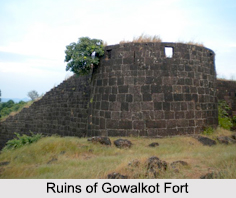 Gowalkot Fort is located on the southern bank of the Vashishti River at a distance of 10 km from the Chiplum city of Raigad District in Maharashtra. Three sides of the fort are guarded by the river and the fourth side is by a trench. According to the local people of the region of the fort, most of the part of Gowalkot was owned by a Hindu king who was later converted to Muslim; his surname was Chougle. It is assumed that all the owners of this land must have received the land as a gift from the Chougle family.
Gowalkot Fort is located on the southern bank of the Vashishti River at a distance of 10 km from the Chiplum city of Raigad District in Maharashtra. Three sides of the fort are guarded by the river and the fourth side is by a trench. According to the local people of the region of the fort, most of the part of Gowalkot was owned by a Hindu king who was later converted to Muslim; his surname was Chougle. It is assumed that all the owners of this land must have received the land as a gift from the Chougle family.
History of Gowalkot Fort
Gowalkot Fort was owned by Shivaji Maharaj in 1660 and he renamed it as Govindgad. Then Sambhaji Maharaj lost it to the Siddi group of people. In 1736, Chimaji Appa won this fort by killing the Siddi Sat in battle. In that battle, Siddhi Sat lost 1300 soldiers and Maratha army lost 800 soldiers. Then in 1745, Tulaji Angre/ Sarkhel Tulaji captured the fort. Later in 1755, Angre again lost it to the Peshwa and eventually in 1818 East India Company took control from the Peshwa.
Structure of Gowalkot Fort
Most of the fort is in ruins now. The fort is spread over two acres of land. There is a temple of goddess Karanjeshwari near the foot hills of the fort. There are buildings and dwellings and a dry well of 22 ft inside the fort campus. There were about 22 cannons around the fort, out of which 10 cannons were shifted from the port area to the fort in 2017 by archeologists of Pune and Chiplum; the longest cannon is 7.5 feet in length among them. The cannons were made by the British, but they were supposed to have been used by the Maratha Army.
This article is a stub. You can enrich by adding more information to it. Send your Write Up to [email protected].



















